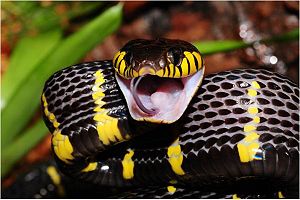From Proteopedia
proteopedia linkproteopedia link
| This Sandbox is Reserved from 01/04/2014, through 30/06/2014 for use in the course "510042. Protein structure, function and folding" taught by Prof Adrian Goldman, Tommi Kajander, Taru Meri, Konstantin Kogan and Juho Kellosalo at the University of Helsinki. This reservation includes Sandbox Reserved 923 through Sandbox Reserved 947.
|
To get started:
- Click the edit this page tab at the top. Save the page after each step, then edit it again.
- Click the 3D button (when editing, above the wikitext box) to insert Jmol.
- show the Scene authoring tools, create a molecular scene, and save it. Copy the green link into the page.
- Add a description of your scene. Use the buttons above the wikitext box for bold, italics, links, headlines, etc.
More help: Help:Editing
|
B. Dendrophila monomeric toxin (Denmotoxin) is the primary protein of snake venom used by Boiga dendrophila. This colubrid snake lives in Southest Asian lowland rainforest and mangrove swamps using birds as its primary prey.
One of the most well characterized snake venom protein families is the Three-finger-toxins (3FTX). These proteins have three β-stranded finger-like loops, stabilized by four disulphide bridges on the surface of a globular core. In non-convential 3TFXs a fifth disulphide bridge can be present as is the case in Denmotoxin.
How the overall structure looks like? Subunits orientation, chains: the number and relative positions, etc.
Denmotoxin
|
Denmotoxin is a snake venom protein produced by Boiga dendrophila (mangrove catsnake) which belongs to a family of well studied three-fingered neurotoxins.
Denmotoxin belongs to a family of curaremimetic neurotoxins
Structure
Denmotoxin is a non-covalent monomeric protein possessing 77 amino acid residues including 10 structurally important cysteines. Multiple sequence alignment of denmotoxin reveals that the venom belongs to the family of non-conventional 3FTXs. Denmotoxin consists of 3 polypeptide loops; importantly the cysteines of the toxin form which stabilize the structure. Four of these disulphide bonds are located at the central core and fifth at the tip of the first loop. Denmotoxin has 7 additional amino acid residues in its N-terminal when compared to other elapid 3FTXs; the N-terminus is also blocked by a pyroglutamic acid residue. The cysteine residues of all 3FTXs are highly conserved, whereas the other residues within the sequence express high variabilty. The biological function of the pyroglutamic acid residue is currently unknown. There are two highly flexible regions on the protein: one at the tip of the central loop and one at the 3 first residues of the N-terminus.
Denmotoxin interacts with acetylcholine-receptors
Biochemistry of denmotoxin is unique for its specifity to bird nicotinic acetyl choline receptors (nAChR). Binding of denmotoxin to a chick muscle AChR (a1ByS) is a highly irreversible when interaction with identical subunit assembly in mouse AChR was reversible. Here a picture of the complex where the toxin is bound to the AChR. The active sites which interact with the receptor.
Active site organisation
Conclusions
Snake venom can kill!
|
Additional Information
References

